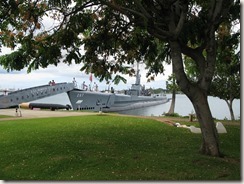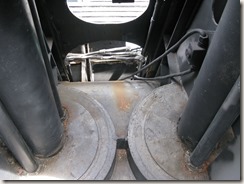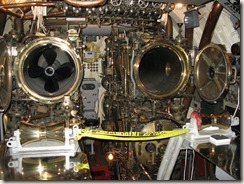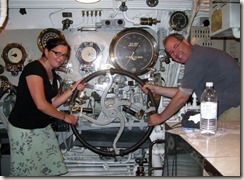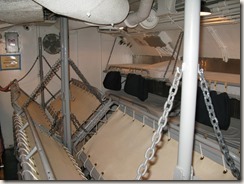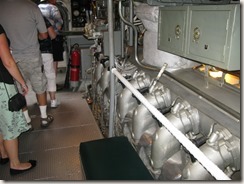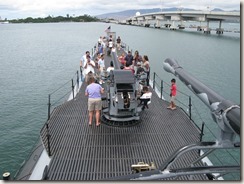Oahu - Day 2 - U.S.S. Bowfin tour and the hidden cost of war
After seeing the Arizona Memorial, we visited two other ships at the park.
Our first stop was the WWII submarine, U.S.S. Bowfin (SS-287). I'd never been on a submarine before and had always wondered what they were like inside (especially after seeing all those movies).
The Bowfin was launched exactly one year after the Pearl Harbor attack, earning her the nickname "The Pearl Harbor Avenger." She completed nine complete tours, and sunk many vessels during the war.
A tour of the U.S.S. Bowfin
The first thing that I noticed was the deck of the submarine actually sits far above the hull of the ship -- so much so that you feel a little uneasy when you walk above it. Pipes and other machinery criss-cross the hull in this space. Here's a photo I took that shows what this looks like:
The red rectangle in these blueprints will give you some idea of how much space is below the deck line (note that the deck slopes up).
Upon entering the sub from behind the Escape Trunk area, we dropped into the forward torpedo tube bay. It was here I began to get some idea of the complexity of this machine. It actually reminded me of a Apollo Command Module or some of the other spacecraft I've seen.
It was no surprise the submarine was a cramped space, but I was able to move easily through the compartments.
The command area of the sub contains all the dials, gauges, and controls you see in those WWII movies. Here, Brenda and I are operating the wheel that submerges the sub:
Here's where the crew slept:
Here's one of the two engine rooms:
Once outside again, I walked up to the conning tower and looked back. I was surprised at how high up the conning tower was, and how big the guns were.
The hidden cost
What I sometimes forget when looking at the machines of WWII is that they were designed to destroy the enemy. And while the Bowfin did her job with distinction, I read a sad story about a ship that she sunk that highlights the hidden cost of the war.
On August 22, 1944, the Bowfin sank the Tsushima Maru off the coast of Akusekijima. The Tsushima Maru was an unmarked, unlighted passenger-cargo vessel. What the Bowfin crew didn't know -- and didn't find out until 20 years later -- was that the Tshushima Maru was carrying 826 children. As the Bowfin website recounts:
"They, along with some of their school teachers and a few of their parents, were being transported from Okinawa to the mainland of Japan to escape the anticipated invasion of the Ryukyu Islands. Of those children, 767 were lost; only 59 were saved. Survivors of the sinking were not allowed to speak of the incident under threats of extreme punishment."
In total, 1,484 civilians were killed. To put this in perspective, when the Titanic went down, 1,502 people died. 1,771 men perished aboard the Arizona.
In World War II, it's estimated that between 62 and 78 million people died. Of this total, 40 to 52 million civilians died. Military deaths accounted for 22 to 25 million.
As horrifying as the Tshushima Maru sinking is, this is only one of the incidents that took innocent lives during this war.
Read Kiyoshi Uehara's account of surviving the Tshushima Maru sinking.
